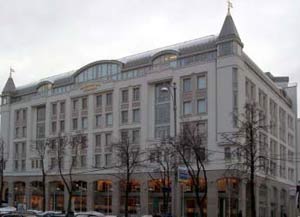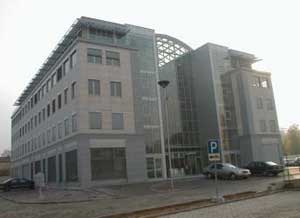Experience in operating domestic “smart buildings”.
The author works for a large company engaged in the integrated operation of modern class A and A+ buildings. These are almost two dozen objects with a total area of more than 30,000 square meters. m.
Almost every building is equipped with a set of life support and security systems, which are components of the so-called “intelligent building”. The presence of such systems is a necessary attribute for modern office buildings (A, A+) and shopping and entertainment centers.
 |
 |
| Our objects: Berlin HouseOur objects | Our objects: DaimlerChrysler House |
In this article I would like to talk about our company and share our accumulated experience in the implementation and operation of intelligent buildings.
The projects implemented by our company in Russia since 1999 occurred at a time when automatic control systems for building engineering equipment had just begun to appear. M+W Zander Facility Management CIS GmbH fulfilled contractual obligations for technical supervision and re-operation control of projects (including tenders), quality control of project implementation, and participated in acceptance tests with subsequent commissioning of facilities.
Our Customers are building owners, large tenants, and companies investing in construction. Our direct “opponents” during the implementation of projects are large construction companies, general contractors and subcontractors. Among them are well-known foreign companies Skanska, Enka, AMR, Rebau, as well as large Russian organizations.
The word “opponent” perfectly describes our relationship in the process of fulfilling contractual obligations to a common Customer, however, working “for results”, we, of course, are colleagues and our joint task is to create a quality product. Many projects implemented by M+W Zander Facility Management CIS GmbH can serve as examples of the implementation of the concept of an “intelligent building” for training using various software and hardware, especially since we install equipment from the world’s best manufacturers — Siemens, Honeywell, Johnson Controls, TAC, Sauter, EFF—EFF, ESSER, etc.
Our archive has literally gigabytes of information about various objects, both at the detailed design stage and in the form of as-built documentation. In fact, there is a large electronic library of technical descriptions and manuals for all software and hardware found at the facilities implemented by our company. The library materials are actively used by company specialists at all stages (operation, technical supervision, construction and engineering consulting, etc.) of work with projects, including intelligent buildings.
Boldly and without quotation marks using the term “intellectual building”, we, of course, slightly embellish the real state of affairs that exists in our country. What is actually happening?
By allocating funds for the “intelligence” of a square meter, the investor first of all hopes to receive the following:
1. Greater reliability, efficiency and safety of engineering systems.
2. Creating more comfortable conditions for tenants and visitors.
3. Reducing the cost of maintaining engineering equipment and optimizing energy costs.
The introduction of automated control systems (ACS) by default brings a certain level of reliability and efficiency to the engineering equipment of buildings, while reducing operating costs.
ACS of life support systems for buildings from Siemens, Johnson Controls, Honeywell, TAC and Sauter are recognized brands both in the Western and our markets (more than 90% of projects).
The current integrator of automated control systems for buildings does not have such a large selection of basic tools for implementing projects, and when choosing a system, an investor does not have to think much about the functional, technical characteristics and cost of the proposed systems, since they all have approximately the same high quality of components and approximately the same cost .
The question is in choosing a specific integrator, in the quality and cost of the services provided (for example, timely and sufficient technical support during the operation phase) and, most importantly, in the quality of execution of the engineering part of the project, its functional content. This is where the “domestic nature” of the implementation of solutions manifests itself, caused primarily by the specifics of the Russian consumer market and the elementary lack of necessary experience of integrators.
The situation becomes significantly more complicated if we take into account that in most cases the Customer has difficulty imagining what criteria to use to evaluate the quality of the product in the complete absence of special information and the corresponding regulatory framework.
Today, a domestic “intelligent building” looks like this:on the one hand, high-quality components, “bricks” for constructing intelligent buildings in the form of initial software and hardware components from various foreign manufacturers with almost identical characteristics. On the other hand, there is insufficient experience and often low qualifications of integrators, superimposed on the complete “darkness” of the end user of the system. At the same time, even low-skilled specialists using high-quality “bricks” manage to achieve a level of projects that is somehow acceptable in terms of the level of automation.
As a result, in most cases, the built systems implement only basic automation and security functions to the minimum acceptable extent, determined not by the design decisions of the contractor, but by the initial characteristics of the selected software and hardware. The minimum functions that were initially included in the system components by the manufacturer are implemented.
It is simply impossible to go lower. The level of automation achieved, not always by minimal means, ultimately provides the answer to the first of the Customer’s questions above. Namely, increasing the reliability, efficiency of engineering systems and the safety of the building as a whole.
However, the implementation of the following two tasks implies a qualitatively different approach to the execution of systems, which is extremely rare in Russia. To ensure comfortable conditions, optimize energy consumption, and actually reduce operating costs in a modern building, it is necessary to make the most efficient use of all resources included by the manufacturer in the supplied software and hardware.
For example, for automation system controllers this means the use of all built-in software regulation algorithms, protective interlocks and settings such as economizers, separate night and day regulation and control modes.
For operator stations — fully configured “alarm” subsystems, providing operators with information not only about accidents that have already occurred, but also capable of issuing warning messages, focusing, for example, on the exhaustion of the set resource of the actuator and, as a result, the next maintenance.
SCADA systems must be configured with processes for archiving and collecting historical data on changes in various parameters, by analyzing which it is possible to make decisions about changing equipment operating modes. Not only control algorithms should be implemented to directly maintain certain temperature conditions, but also energy-saving algorithms based on automated accounting of energy resources and calendar parameters.
In addition, in a modern building there is a lot of equipment, the performance of which is critical for the operation of the building, but it is not included in the list of basic engineering systems that are automated “by default” (heating, ventilation, refrigeration and water supply).
In reality We are faced with a number of already implemented domestic solutions, where the execution of the listed tasks has not been carried out and expensive installed equipment is used at the minimum of its capabilities.
If the Customer purchased an expensive pump with a built-in frequency controller and an interface for connecting to an automation system, and in the project it is connected like an ordinary asynchronous motor with an on/off function,” there is no need to even talk about the equipment’s payback.
The above is well illustrated by the still practiced approach to the implementation of central operator stations. Modern SCADA systems are equipped with numerous functions for displaying process parameters, recording and storing alarm messages, processing and reproducing trends. In practice, minimal means of display and operator control are implemented on mnemonic diagrams. The “alarm” subsystem, as a rule, is not configured properly at all, historical trends are not recorded, and reports are not even mentioned. With this extremely exaggerated approach to the implementation of the top level of the system, the effect of implementing the entire system as a whole is minimized.
Thus, practically none of the domestic projects have ever been implemented as a full-fledged “intelligent building.”
What is the reason that our integrators are in no hurry to eliminate the lack of experience in terms of creating a truly “intelligent” building? product in the presence of high-quality software and hardware components of automation and security systems?
In our opinion, this is a consequence of a fundamental problem for our market: the discrepancy between the potential capabilities of modern automation and security systems and the consumer level of the “intelligent building” Customer. In fact, existing opportunities remain potential and continue to exist beyond the boundaries of implemented projects.
On the one hand, we have learned to sell “golden intellectual meters”, on the other hand, we are not able to see how this gold glitters, and most importantly, why . This is precisely what determines our low consumer level.
Just like the level of foreign cars is not comparable to the conditions of their operation on our roads.
Russians for the most part are not at all spoiled by comfortable living conditions. Our apartments and houses are not equipped with modern climate control and ventilation systems. We have very vague ideas about a truly comfortable environment for living and working.
For comparison: a German company renting office space from our client quickly responds (with complaints to the operation service) to a change in temperature already within 2 degrees from the established 20-22 degrees, while compatriots are able to work in a wide range of temperatures without causing any problems. special claims. In the West, entire studies have been conducted on the influence of these 2 degrees on the efficiency of an office worker.
The effect of using energy-saving technologies today is often lower than the cost of saved energy resources, and does not allow for the costs of introducing energy-saving technologies, especially since the real effect can be appreciated when considering large periods of time. Today, for most Customers it is cheaper to spend an extra kilowatt than to count it and save it.
Our most effective building security element is an additional security officer or elevator operator. Many are still convinced that it is more economical to organize an additional duty post than to invest in elements of a modern security system. The cost of the salary of a shift service technician often looks more attractive in the eyes of the Russian Customer than the cost of a qualified solution to a technical problem or equipment modernization.
Most domestic Customers, unfortunately, have not developed the level of requirements necessary for investing in an intelligent building , which leads to extremely low motivation of integrator companies and, accordingly, the conditions for the formation of their professional experience.
This is our reality, which, unfortunately, is a natural brake on the path to creating truly high-quality “intelligent buildings”. Probably the only way to eliminate such inconsistencies is time. The time during which our country as a whole will rise to a level of economic development for which the “intelligent building” will become a truly relevant product that meets real needs, and not a common cliché for sale.
